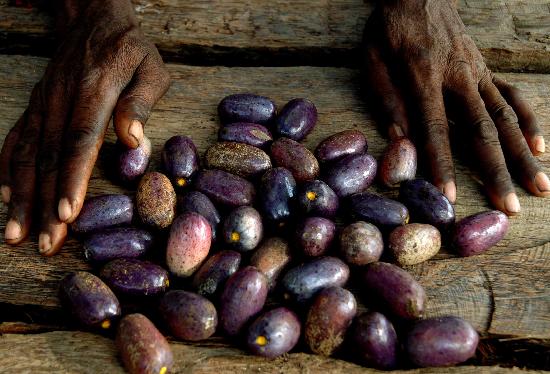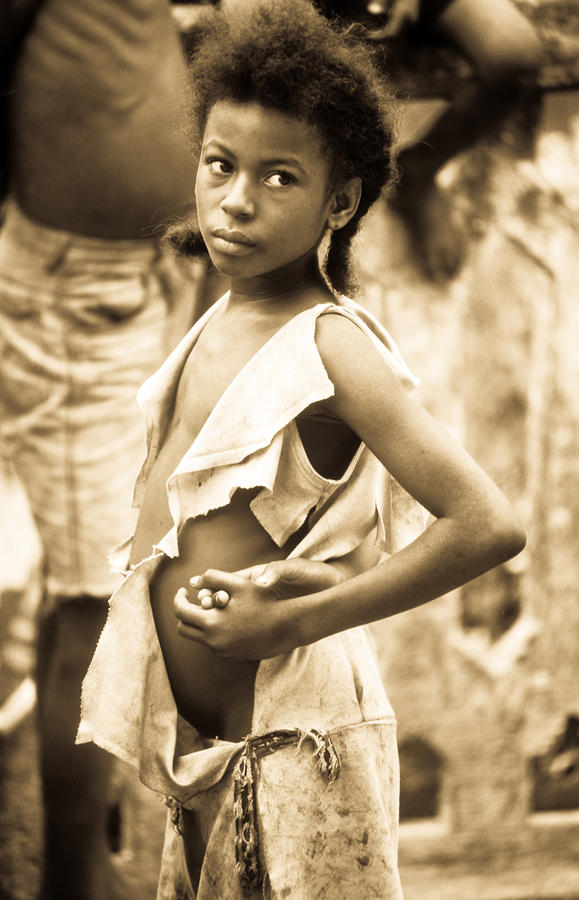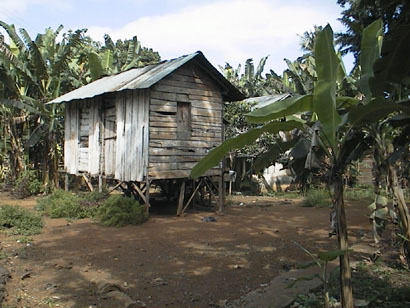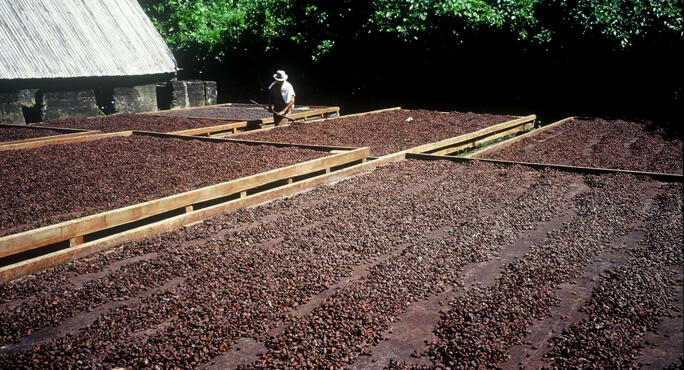
CHOCOLATE AND SLAVERY
From the INTELLIGENT LIFE magazine, "Chocolate and Slavery," the March/April 2013 issue, by Samantha Weinberg -- Once the world’s leading cacao producer, the tiny nation of São Tomé and Príncipe seems to have fallen off the map. Samantha Weinberg, entranced, went twice in a year—and unearthed a dark history
BEFORE I WENT to São Tomé and Príncipe, I wouldn’t have been able to pick out a cacao—or cocoa—pod from a police line-up of tropical fruit. But it is impossible to spend time on this west African archipelago and not become immersed in the culture of chocolate. The two islands—São Tomé is the larger, a comma of green with its tail nudging the Equator; Príncipe, to its north, is smaller and more verdant still—were the first African nation to cultivate cacao, and, for a few years around the turn of the 20th century, the world’s leading cacao producer.
Chocolate, in a way, lured me to São Tomé the first time. It was a bleak midwinter and I had a week to kill between jobs. In a smart London chocolate shop, I’d seen a little pouch of dark chocolate buttons labelled "Origin: São Tomé". It nudged a memory of a friend who had been evacuated from Angola 20 years earlier and found himself on an island "as close to paradise as it’s possible to get". That was São Tomé, and I had heard no further mention of it. The promise of remoteness and chocolate proved irresistible.

A month later I’m on the weekly TAP flight from Lisbon, wedged between two women with braided hair. Woken as we begin our descent over the Gulf of Guinea, I crane towards the window for a glimpse of the islands. I have no idea what to expect: a rummage around the internet revealed little apart from that it rained a lot and that there were no cash machines for visitors. But here it is: a green, mountainous mass, sloping down to slim crescents of pale sand skimming the edges where the forest gives way to the blue of the ocean. When São Tomé was discovered by two Portuguese explorers, João de Santarém and Pedro Escobar, in about 1470, it was probably uninhabited, and even now there is little sign that it was once among Portugal’s most productive dependencies.
Although the islands are steamily beautiful, it is hard to imagine what made Portugal think that they would be a useful colony. They’re small—only 1,001km between the two of them—volcanic and thickly vegetated. Exploring São Tomé and Príncipe, on foot, by jeep and on a bike, I am struck again and again by the power of that nature, both to feed—crops grow here almost visibly—and to destroy. The pavements of the capital (also called São Tomé) are ruptured by roots that force their way up through the thick stone. In the virgin rainforest, giant figs strangle the life out of tall oka trees and without constant care each cacao tree or coffee bush is soon smothered under a blanket of vines, so it is almost impossible to make out where the abandoned plantations were.
The early settlers, and the slaves they brought from mainland Africa, had to cope with disease and isolation. They hacked away at the forest and planted sugar cane and pepper. It must have been a constant battle to plant, nurture and harvest, and keep the crops clear of weeds in the wet heat of the tropics. In time São Tomé was trumped by Brazil, where the terrain was better suited to large-scale agriculture.
It wasn’t until the 1820s that São Tomé and Príncipe found their métier. Cacao had been grown since the time of the Aztecs in Central America, but only in a narrow girdle around the Equator, between 18 degrees north and 15 degrees south. By the early 19th century, however, the European tongue had been so tantalised by the taste that demand started to outstrip supply. "And so cacao set forth into its great diaspora," Paul Richardson writes in "Indulgence: Around the World in Search of Chocolate" (2003). "How it travelled is something of an enigma, since cacao beans lose their ability to germinate after a couple of weeks and the portable Wardian greenhouse…had not yet been invented." Somehow a Brazilian named João Baptista Silva managed to keep them fertile during the Atlantic crossing, and the first plants were introduced on Príncipe in 1820. When they responded well to the conditions, they were shipped on to São Tomé. Over the succeeding decades more land was cleared for more acres of plantations, more slaves imported mainly from Angola, more settlers, more machinery. And more cacao.

CARLOS HAS BEEN recommended to me as the best guide on the island. A young, pale-skinned man, he seems to bridge the gap between old and new São Tomé. He speaks four languages, wears his jeans fashionably low and has a Facebook page. Yet he knows which plant can be used as washing powder and which protects against the evil eye, and he can shimmy up a coconut palm as though it was a flight of stairs.
We set out on a tour of the old roças, the plantations that are scattered across both islands. As we’re heading north, Carlos swings off the only tarred road and comes to a stop. He gets out and plunges into the dusk of the forest, re-emerging with what looks like a golden grenade in each hand. They are more or less the same size, with indented stripes stretching from one end to the other. He bashes one against the tyre of the jeep and peels off the thick outer skin to reveal a dome of translucent white flesh, protecting an inner core of pips. I break off a section and suck—it tastes both sweet and sharp, like a half-ripe mango. But when I spit out the pips and go to chuck them into the undergrowth, Carlos puts up his hand: "Wait a minute, that’s not it."

We climb back into the jeep and drive a little farther, through a pair of crumbling gateposts. The road turns a corner and in front of us, enthroned at the top of grand, curved steps, is a two-storey building, painted Germolene-pink. From a distance it is dramatic; there are 13 windows on the upper floor under a tiled roof, with long wings below on either side. "It was the plantation hospital," Carlos says.
We park next to an ancient tractor and look around. Close up, the hospital is a shell, the double doors locked, the windows shuttered. A goat is standing at the top of the steps, silhouetted against the mottled sky. Stretching back along the drive, beyond the once-white walls, is a rubble of low buildings. Children are careering down the cobbled road on makeshift go-karts—no more than crates on mismatched wheels—whooping and laughing. A pair of old men sit on stools on the pavement, watching.

Carlos leads the way to an open barn-like structure. Filling most of the building is a stone platform covered with what look at first like almonds. I pick up a handful and realise that they are pips, similar to the ones I was just sucking, only these are warm, their husks roasted and crispy. I rub one between my fingers and another layer comes off to reveal an inner kernel, dark brown, smooth and shiny. Carlos carefully extracts a tiny pin from one end, and hands the rest back to me. "This is cacao, this is what these islands are about. Go on, taste it."
THE ESSENCE OF raw chocolate—bitter, rich, nutty—lingers on my tongue as we arrive at Roça Monte Café, up in the hills above São Tomé city. I stop to take a picture of an old man wearing a smart corduroy cap and polished shoes. He has a lovely smile and a gentle voice. He says the same thing, over and over: "I was brought here 50 years ago from Cape Verde, a virtual slave," Carlos translates. "For 50 years I worked as a slave does."
Portugal officially abolished slavery in 1876. But the cacao wouldn’t turn a profit without cheap workers, so the landowners devised a covert version of forced labour, "recruiting" workers on contracts that gave them minimal recompense for heavy work and left little room for voluntary repatriation. As we walk around, Carlos points out the beautiful old casa grande, where the owner would stay when he was visiting from Portugal, and the former hospital. "All the big roças had hospitals," he says. "They had schools and morgues and cemeteries. Most of the people who came to work on the plantations never left."

A small child in tattered clothes with a wild-haired doll strapped to her back takes my hand and leads me down the cobbled street, where the old slave quarters merge into a jumble of wooden shacks. It’s busy: teenage girls are singing as they wash clothes in a communal stone sink, a woman crouches in front of three small pyramids of tomatoes. There is little else here: the hulk of an old tank, a small Libyan-owned coffee operation, but no shops or bars or cars.
We stop at Roça Água Izé on the way back into town and Carlos shows me the old hospital: with its curved steps and towers, it could be Norma Desmond’s mansion from "Sunset Boulevard", fallen further into decay. There’s a family camped in a room at the back, a goat dozing in the courtyard and trees growing out of the walls, but apart from that it is empty. "My mother was born in that hospital," Carlos says. "My grandfather worked in the cacao plantation, but he managed to get out and set up a small business making alcohol on Príncipe." His mother now works as a laundress at Bom Bom, Príncipe’s one chic resort. I ask what the people do now for work. "They grow food and sell it in the market. Some are fishermen, some still work on the plantation. It’s one of the only ones still going." We find the foreman, who unlocks a series of warehouses. In the first are lines of jute sacks filled with cacao; in the next, wooden fermenting troughs—though only a fraction contain fruit. It smells cloying and sharp, like an orchard at the end of a wet autumn. The great drying ovens are quiet, and in a vast structure at the back is a sprawling machine with pulleys, pumps and presses. The sun shines through the high windows, picking out a crochet of cobwebs covering every strut and girder. With a look of pride, the foreman pushes a button and the machine creaks into motion; Heath Robinson’s imagination brought to life.

On my last afternoon, I buy chocolate at the museum. It is unlike any chocolate I’ve tasted: soft and slightly grainy, with a flavour that gets more intense as it melts on your tongue. It is made by an Italian called Claudio Corallo and I want to know how he does it, so we call in at his house, on the main esplanade, only to find he’s away in Europe.
Instead I go to the Cacao Centre, a cultural space housed in the old railway station, where I sit on my own and watch a film of late-19th-century plantation life. In patchy black-and-white, an overseer walks out in a pale suit and solar topi. The bell tolls and hundreds of slave men and women scurry out to be counted. I recognise the long avenue of the first roça we went to—then called Rio do Ouro, River of Gold—with the pink hospital, though in the film everything is immaculate, the grass trimmed and the buildings gleaming white. There are young, muscled men with white cloths wrapped round their waists and women in starched aprons, some with a baby strapped to their back. Are they the parents of the old men I saw sitting on stools, the great-grand-parents of the children playing on go-karts? Back in the plane, watching the island merge back into a solid green, I feel sad. Sad to be leaving and sad about what I have just begun to understand.

IN LATE AUGUST, Gravana, the dry season, is drawing to a close. The tall flame trees are beginning to sport their vivid orange blossom, a sign that rain is on the way. I am back, this time with my family. I want to show them the beach on Príncipe where I had watched a giant turtle digging the perfect nest to shelter her eggs; to climb back up through the rainforest to Lagoa Amelia, named after a Portuguese girl who fell into a crater disguised by vines; and to swim with them in the vast shimmering shoal of sardines at Lagoa Azul. I am also determined to meet Claudio Corallo.
Back in England, I had read Miguel Sousa Tavares’s novel "Equador" (Equator), set in São Tomé at the turn of the 20th century, when half the world was eating chocolate produced from Santoméan cacao. The islands he describes are full of familiar places: his hero, Luís Bernardo Valença, swims off Seven Waves beach, rides through the obô (primary forest) to Roça Rio de Ouro and spends time in the south, near Porto Alegre, where I had watched loggerhead-turtle hatchlings being released back into the ocean. But the plantation culture he paints, with its thrice-daily rollcall, 24-hour shifts, brutal overseers with whips and guns, and the soulful sung lament of the workers, was at odds with the gentle pace of life I’d seen and the proud, friendly people I’d met.

Tavares’s story hinges on the visit of a British emissary, sent to check whether the Portuguese were keeping to the terms of the end-of-slavery treaty. It is based on the real visit of William Cadbury of Cadbury’s chocolate, who met plantation owners and then reported: "Most of the mortality is from two diseases—anaemia and dysentery; complaints that are easily developed by people in a depressed mental condition…this is exactly what one would expect when we know that these people are forcibly taken from their homes for work across the sea, without any hope of return." Cadbury’s report was seen by the Portuguese as an attempt to get the world buying cacao produced in the British colony of the Gold Coast (now Ghana), and it had a devastating effect on São Tomé. British chocolate manufacturers boycotted its cacao and the local industry started sinking.
We drive up through the forest to Roça de Bombaim. There is a light mist, which softens the dark green of the forest and spritzes the air. The gatehouse is almost engulfed in the embrace of a strangler fig. As we drive into a large courtyard, three small boys wave and call out, "Branca, branca" (white). As we slow to a stop, they strike a pose, each clutching a stub of sugar cane, and start rapping.
It takes a moment to work out that they’re singing in English, something bang-recent by Jay-Z. When they finish, we applaud and they bow and scamper away, along the front of a line of buildings, also deserted and subsiding, and round the corner to the old slave quarters. Later, heading out for a swim in a nearby waterfall pool, we are stopped by a pair of old men wearing gumboots. They have few teeth and yellowing beards, and it soon becomes apparent that they are drunk on palm wine. When they see us, they salute, stand up straight and start singing the Portuguese national anthem, out of tune.

In 1975 the Portuguese pulled out of their remaining African colonies: Mozambique, Angola, Cape Verde and São Tomé. They went quickly, leaving almost everything—houses, furniture, tractors and trains, and about 80,000 descendants of slaves and contract workers, most of whom had no experience of life away from the strict regimen of the roça.
Carlos jokes with the old men before commissioning them to buy us a bottle of fresh palm wine. They told him that they had worked their whole life up here in the cloud. I ask how he feels about the past and he shakes his head. "Too many people are still living it. We have to let go and move forward. The Portuguese left us their plantations and their houses, but we are letting it all go to ruin."
Upstairs in the casa grande, a salmon villa with a touch of the teahouse about its eaves and its wrap-around wooden balcony, I can almost see the ghosts of those old colonists and their corseted wives, dancing while the workers sang of home in the cramped slave quarters. The generator has run dry of fuel and we are the only guests. Dinner is delicious—fresh swordfish and vegetables grown in the walled garden, lightly spiced chicken for the children, fresh papaya and star fruit for pudding. We eat by candlelight and then Carlos teaches us a local card game called Bishka, which is as fiendishly complex as only a game developed over years in a closed-circuit community can be.

A car draws up outside. There is a whoosh and the room is bathed in light. A Brazilian soap opera bawls from the television, and four Santoméans run in out of the night, laughing and shouting — the girls in tight skirts, the men wearing sunglasses on top of their shaven heads. Someone turns the music up and we dance on the terrace overlooking the forest. The next morning, I wake up early—the mist is lifting from the trees, the birds are singing and the ghosts of last night have disappeared.

Príncipe is a purer version of São Tomé, with a population of 6,000 and, in Santo António, the smallest city in the world. The painted wooden houses are neat, the Príncipeans relaxed. It strikes me as the opposite of "Lord of the Flies": its isolation has brought apparent harmony. We spend a day at Bom Bom Island Resort which, with two of the larger roças and another beach, has recently been bought by a South African high-tech billionaire and space tourist, Mark Shuttleworth. He has shipped in agronomists and architects, sociologists and experts in cacao and coffee and tropical forests, and dreams of transforming Príncipe into a sustainable island paradise. Claudio Corallo thinks he will turn it into "Disneyland".
Corallo’s plantation, Terreiro Velho, is at the end of a rutted track. The old house is shuttered and looks forlorn. But the view, towards the undulating virgin rainforest in the south, with its empty beaches and high waterfalls, is dramatic. The cacao trees are short, with glossy, flat green leaves and pods hanging down from the branches and growing straight out of the trunks, in a spectrum of colours from deep aubergine through watermelon green to the warm gold of ripe papayas. They look well cared for, sheltering under the high canopy that provides the shade they need.

After the beans are fermented and dried, they’re sent back by boat to São Tomé, dehusked and depinned, before being delivered, stripped and ready for transformation, to Corallo’s base in the city. Arriving early in the morning, I am led around the edge of his yellow villa to a low, wooden building at the back, with a corrugated-iron roof. Claudio Corallo is waiting, lean and tanned, with a white moustache. He has lively eyes behind metal-rimmed glasses, and an energy and precision to everything he says and does.
Speaking in French, he opens the door to his laboratoire. The smell of chocolate billows out, warm and smooth. We sit on stools at a high wooden bench and look around. On shelves lining the room are bottles filled with raisins steeping for three months in homemade cacao liquor; later, these will be encased in dark chocolate to make a bar that is rich, hot and somehow transcending. Workers wearing white coats, nurse’s hats and masks are stirring and smoothing the chocolate, and others cutting and packing it and labelling the little cardboard boxes: 100% Cocoa, 80% Sablé, Soft 70% with nibs, etc. My daughter’s eyes are wide and she is almost visibly salivating. Over the past two weeks we have eked out two boxes of Corallo chocolate, allowing ourselves a small slab each night. On Príncipe, in our simple, remote guesthouse, it has felt as precious as Charlie Bucket’s birthday bar.

Corallo tells us his story: after university in Florence, he moved to the Belgian Congo, where he managed a coffee plantation in the dark heart of the country, shipping the beans along the Congo River. At 1,650km, it was bigger than this entire nation. In 1993, when the situation there became too tense, he moved his family to São Tomé. What started as a lifestyle decision became an obsession when he discovered Terreiro Velho. "I didn’t know anything about cacao and didn’t like chocolate," he says. "I bought all the best brands to learn the tastes." He pulls out a bar of Lindt and gives us each a square. "First you will have an explosion of sugar, then vanilla, very strong, then bitterness and a gluey sensation in your mouth. There is no taste of cacao." He wrings his hands. "It should be like a grand vin, like a melody of taste."
He cleared the land, trimmed the canopy—"you need sunlight like confetti"—replanted the cacao and developed his own methods of roasting and refining his chocolate. Once ready, it is shipped to his shops in Lisbon, Nyon in Switzerland and Berkeley in California, and to retailers around Europe. "What makes it possible is the spirit of the people here, their quality and exactitude. I tell them every day, we are the best in the world, by miles."

We spend our last evening at Paraiso dos Grelhados, a restaurant operating out of an old blue ship’s container parked on the esplanade. We eat concón, flying gurnard, cooked on a half-barrel barbecue and drink local beer. People keep joining our table: Carlos and two biker friends, the leader of the Socialist Party, the chief justice and a man who grows porcelain roses. After dinner, we go to a party in the park to celebrate the end of Gravana, where there are food stalls and old popcorn-makers, redolent of 1950s fairs, children’s games, music and dancing. There are no laments, few Portuguese and no chocolate.
We leave early in the morning, heavily armed with boxes of Corallo and an earnest vow: to savour chocolate. It will never taste quite the same again. (source: INTELLIGENT LIFE magazine, March/April 2013; Samantha Weinberg is our assistant editor and the author of "A Fish Caught in Time".)


I simply could not leave your site before suggesting that I really loved the
ReplyDeleteusual info an individual provide in your visitors? Is gonna be back
incessantly to check out new posts
Also visit my web-site ... jocuri wii online
I know this site gives quality based articles and extra data, is there
ReplyDeleteany other web site which provides such stuff in quality?
My page Ricardo
Thanks for the good writeup. It in truth was once a
ReplyDeleteenjoyment account it. Glance complicated to more added agreeable from you!
However, how can we keep up a correspondence?
My web-site: Dusty
I appreciate you taking the time and effort to write such great content. I appreciate your hard work.
ReplyDeleteTop 10 engineering colleges in Dehradun